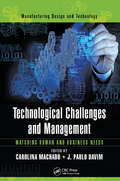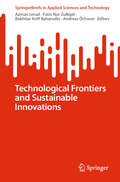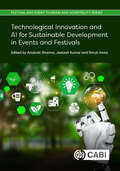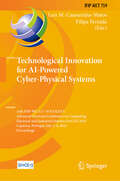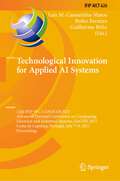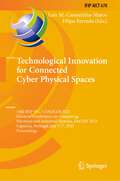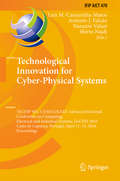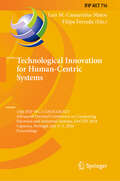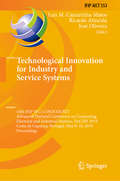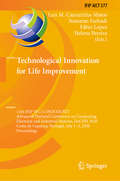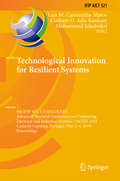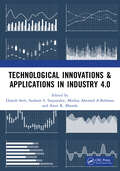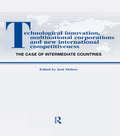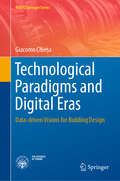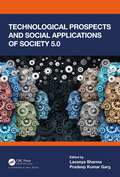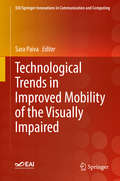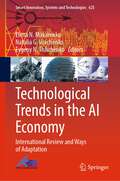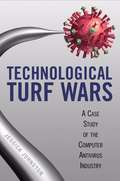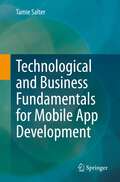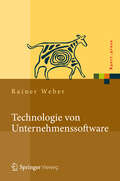- Table View
- List View
Technological Challenges and Management: Matching Human and Business Needs (Manufacturing Design And Technology Ser. #2)
by J. Paulo Davim Carolina MachadoToday's organizations find themselves in a race to adopt new technologies in order to keep up with their competition. However, two questions must be answered: Are these organizations ready for new technological advancements, and are these new technologies appropriate for every organization? Technological Challenges and Management: Matching Human an
Technological Frontiers and Sustainable Innovations (SpringerBriefs in Applied Sciences and Technology)
by Andreas Öchsner Azman Ismail Fatin Nur Zulkipli Bakhtiar Ariff BaharudinThis book takes a deep dive into the industrial sphere, exploring subjects such as aerospace development, knowledge management in higher education, and the emergence of a nation as a player in the global space race. This insightful compilation of chapters offers an essential guide to navigating the complexities of modern industry, offering valuable insights and solutions to propel businesses and society toward a sustainable future.
Technological Innovation and AI for Sustainable Development in Events and Festivals (Festival and Event Tourism and Hospitality Series)
by Anukrati Sharma Jeetesh Kumar Shruti AroraFrom sustainable event planning to the influence of VR, AI, and mobile applications on tourist behaviour, this book explores the dynamic landscape where innovation meets tradition. It studies the intersection of green technologies, sustainable infrastructure, and the delicate balance between cutting-edge tools and the intrinsic emotional aspects of human engagement. Aligned with the United Nations' 17 Sustainable Development Goals, the book highlights AI's potential to drive meaningful contributions to a sustainable future. It anticipates the imminent transformation of festivals and events through technological innovation and AI implementation. It will allow the reader to gain insights into how automation streamlines logistics, optimizes marketing efforts, and enhances the overall attendee experience. The book offers readers: · A cutting-edge exploration of the transformative impact of technologies and artificial intelligence on the events and tourism industries. · Oversight of how new technology can align with the United Nations' 17 Sustainable Development Goals - readers can anticipate insights into how AI can contribute meaningfully to understanding and addressing pressing global challenges. · Practical insights for stakeholders including actionable insights that go beyond theory. It will be an essential reference for academic researchers and practitioners within events and tourism management.
Technological Innovation for AI-Powered Cyber-Physical Systems: 16th IFIP WG 5.5 / SOCOLNET Advanced Doctoral Conference on Computing, Electrical and Industrial Systems, DoCEIS 2025, Caparica, Portugal, July 2 - 4, 2025, Proceedings (IFIP Advances in Information and Communication Technology #759)
by Luis M. Camarinha-Matos Filipa FerradaThis book constitutes the refereed proceedings of the 16th IFIP WG 5.5/SOCOLNET Advanced Doctoral Conference on Computing, Electrical and Industrial Systems on Technological Innovation for AI-Powered Cyber-Physical Systems, DoCEIS 2025, held in Lisbon, Portugal, during July 2–4, 2025. The 29 full papers presented were carefully reviewed and selected from 60 submissions. They were focused on topical sections as follows: AI in Business Applications; AI in Industry 4.0; Smart Systems in Sustainable Development; AI-Powered Healthcare; AI in Systems, Decision & Control; Intelligent Sensing & Communication Systems; Smart Power Systems; Electronic Systems.
Technological Innovation for Applied AI Systems: 12th IFIP WG 5.5/SOCOLNET Advanced Doctoral Conference on Computing, Electrical and Industrial Systems, DoCEIS 2021, Costa de Caparica, Portugal, July 7–9, 2021, Proceedings (IFIP Advances in Information and Communication Technology #626)
by Luis M. Camarinha-Matos Pedro Ferreira Guilherme BritoThis book constitutes the refereed proceedings of the 12th IFIP WG 5.5/SOCOLNET Advanced Doctoral Conference on Computing, Electrical and Industrial Systems, DoCEIS 2021, held in Costa de Caparica, Portugal, in July 2021.*The 34 papers presented were carefully reviewed and selected from 92 submissions. The papers present selected results produced in engineering doctoral programs and focus on technological innovation for industry and service systems. Research results and ongoing work are presented, illustrated and discussed in the following areas: collaborative networks; smart manufacturing; cyber-physical systems and digital twins; intelligent decision making; smart energy management; communications and electronics; classification systems; smart healthcare systems; and medical devices. *The conference was held virtually.
Technological Innovation for Connected Cyber Physical Spaces: 14th IFIP WG 5.5/SOCOLNET Doctoral Conference on Computing, Electrical and Industrial Systems, DoCEIS 2023, Caparica, Portugal, July 5–7, 2023, Proceedings (IFIP Advances in Information and Communication Technology #678)
by Luis M. Camarinha-Matos Filipa FerradaThis book constitutes the refereed proceedings of the 14th IFIP WG 5.5/SOCOLNET Advanced Doctoral Conference on Computing, Electrical and Industrial Systems, DoCEIS 2023, held in Monte da Caparica, Portugal, during July 5-7, 2022. The 22 full papers presented were carefully reviewed and selected from 47 submissions. The papers cover the following topics: energy communities; smart energy and power systems; intelligent manufacturing; health and biomedical information systems; intelligent computational systems; and electronics and communications.
Technological Innovation for Cyber-Physical Systems
by Luis M. Camarinha-Matos António J. Falcão Nazanin Vafaei Shirin NajdiThis book constitutes the refereed proceedings of the 7th IFIP WG 5. 5/SOCOLNET Advanced Doctoral Conference on Computing, Electrical and Industrial Systems, DoCEIS 2016, held in Costa de Caparica, Portugal, in April 2016. The 53 revised full papers were carefully reviewed and selected from 112 submissions. The papers present selected results produced in engineering doctoral programs and focus on research, development, and application of cyber-physical systems. Research results and ongoing work are presented, illustrated and discussed in the following areas: enterprise collaborative networks; ontologies; Petri nets; manufacturing systems; biomedical applications; intelligent environments; control and fault tolerance; optimization and decision support; wireless technologies; energy: smart grids, renewables, management, and optimization; bio-energy; and electronics.
Technological Innovation for Digitalization and Virtualization: 13th IFIP WG 5.5/SOCOLNET Doctoral Conference on Computing, Electrical and Industrial Systems, DoCEIS 2022, Caparica, Portugal, June 29 – July 1, 2022, Proceedings (IFIP Advances in Information and Communication Technology #649)
by Luis M. Camarinha-MatosThis book constitutes the refereed proceedings of the 13th IFIP WG 5.5/SOCOLNET Advanced Doctoral Conference on Computing, Electrical and Industrial Systems, DoCEIS 2022, held in Caparica, Portugal, during June-July 2022. The 22 full papers presented were carefully reviewed and selected from 48 submissions. The papers present selected results produced in engineering doctoral programs and focus on technological innovation for industry and service systems. The papers are organized into the following topical sub-headings: Smart Systems Thinking; Cyber-physical Systems; health-related Digitalization; Electric Systems and Machines; Smart Devices; and Control and Digital Platforms.
Technological Innovation for Human-Centric Systems: 15th IFIP WG 5.5/SOCOLNET Advanced Doctoral Conference on Computing, Electrical and Industrial Systems, DoCEIS 2024, Caparica, Portugal, July 3–5, 2024, Proceedings (IFIP Advances in Information and Communication Technology #716)
by Luis M. Camarinha-Matos Filipa FerradaThis book constitutes the refereed proceedings of the 15th IFIP WG 5.5/SOCOLNET Advanced Doctoral Conference on Computing, Electrical and Industrial Systems on Technological Innovation for Human-Centric Systems, DoCEIS 2024, held in Caparica, Portugal, during July 3–5, 2024. The 25 full papers presented were carefully reviewed and selected from 53 submissions. The papers cover the following topics: collaborative systems; human-robot collaboration; human-centric biomedical systems; cybersecurity and safety; energy management and sustainability; intelligent computational systems; electronic systems.
Technological Innovation for Industry and Service Systems: 10th IFIP WG 5.5/SOCOLNET Advanced Doctoral Conference on Computing, Electrical and Industrial Systems, DoCEIS 2019, Costa de Caparica, Portugal, May 8–10, 2019, Proceedings (IFIP Advances in Information and Communication Technology #553)
by Luis M. Camarinha-Matos Ricardo Almeida José OliveiraThis book constitutes the refereed proceedings of the 10th IFIP WG 5.5/SOCOLNET Advanced Doctoral Conference on Computing, Electrical and Industrial Systems, DoCEIS 2019, held in Costa de Caparica, Portugal, in May 2019. The 36 revised full papers presented were carefully reviewed and selected from 73 submissions. The papers present selected results produced in engineering doctoral programs and focus on technological innovation for industry and serivce systems. Research results and ongoing work are presented, illustrated and discussed in the following areas: collaborative systems, collaboration and resilient systems, decision and optimization systems, assistive systems, smart environments, smart manufacturing, water monitoring systems, communication systems, and energy systems.
Technological Innovation for Life Improvement: 11th IFIP WG 5.5/SOCOLNET Advanced Doctoral Conference on Computing, Electrical and Industrial Systems, DoCEIS 2020, Costa de Caparica, Portugal, July 1–3, 2020, Proceedings (IFIP Advances in Information and Communication Technology #577)
by Luis M. Camarinha-Matos Nastaran Farhadi Fábio Lopes Helena PereiraThis book constitutes the refereed proceedings of the 11th IFIP WG 5.5/SOCOLNET Advanced Doctoral Conference on Computing, Electrical and Industrial Systems, DoCEIS 2020, held in Costa de Caparica, Portugal, in July 2020. The 20 full papers and 24 short papers presented were carefully reviewed and selected from 91 submissions. The papers present selected results produced in engineering doctoral programs and focus on technological innovation for industry and service systems. Research results and ongoing work are presented, illustrated and discussed in the following areas: collaborative networks; decisions systems; analysis and synthesis algorithms; communication systems; optimization systems; digital twins and smart manufacturing; power systems; energy control; power transportation; biomedical analysis and diagnosis; and instrumentation in health.
Technological Innovation for Resilient Systems: 9th Ifip Wg 5. 5/socolnet Advanced Doctoral Conference On Computing, Electrical And Industrial Systems, Doceis 2018, Costa De Caparica, Portugal, May 2-4, 2018, Proceedings (IFIP Advances in Information and Communication Technology #521)
by Luis M. Camarinha-Matos Kankam O. Adu-Kankam Mohammad JulashokriThis book constitutes the refereed proceedings of the 9th IFIP WG 5.5/SOCOLNET Advanced Doctoral Conference on Computing, Electrical and Industrial Systems, DoCEIS 2018, held in Costa de Caparica, Portugal, in May 2018. The 30 revised full papers presented were carefully reviewed and selected from 74 submissions. The papers present selected results produced in engineering doctoral programs and focus on technological innovation for resilient systems. Research results and ongoing work are presented, illustrated and discussed in the following areas: collaborative systems, decision support systems, supervision systems, energy management, smart grids, sensing systems, electrical systems, simulation and analysis, monitoring systems, and energy distribution systems.
Technological Innovations & Applications in Industry 4.0
by Dinesh Seth Sushant S. Satputaley Minhaj Ahemad A. Rehman Amit R. BhendeThe conference offered an international forum for discussion and exchange of knowledge on opportunities and challenges related with all facets and aspects of technological innovations & applications in Industry 4.0, its challenges and way ahead. The objective of this international conference was to provide a platform for policy makers, academicians and researchers to share their experiences and knowledge by presentation of scientific advances made in the field of Industry 4.0.
Technological Innovations in Sensing and Detection of Chemical, Biological, Radiological, Nuclear Threats and Ecological Terrorism
by Ashok Vaseashta Eric Braman Philip SusmannThis book arises from the NATO Advanced Study Institute "Technological Innovations in Detection and Sensing of CBRN Agents and Ecological Terrorism" held in Chisinau, Republic of Moldova in June 2010. It comprises a variety of invited contributions by highly experienced educators, scientists, and industrialists, and is structured to cover important aspects of the field that include developments in chemical-biological, and radiation sensing, synthesis and processing of sensors, and applications of sensors in detecting/monitoring contaminants introduced/dispersed inadvertently or intentionally in air, water, and food supplies. The book emphasizes nanomaterials and nanotechnology based sensing and also includes a section on sensing and detection technologies that can be applied to information security. Finally, it examines regional, national, and international policies and ethics related to nanomaterials and sensing. It will be of considerable interest and value to those already pursuing or considering careers in the field of nanostructured materials and nanotechnology based sensing, In general, it serves as a valuable source of information for those interested in how nanomaterials and nanotechnologies are advancing the field of sensing, detection, and remediation, policy makers, and commanders in the field.
Technological Innovations, Multinational Corporations and the New International Competitiveness: The Case of Intermediate Countries (Routledge Studies in Global Competition)
by JosThe aim of this book is to contribute to a better understanding of those intermediate countries with specific reference to two relevant international areas; those countries of southern Europe whose dynamic is very much influenced by the phases of European construction, and in countries of Latin America where the opening up process has changed the traditional role played by multinational corporations.
Technological Paradigms and Digital Eras: Data-driven Visions for Building Design (PoliTO Springer Series)
by Giacomo ChiesaThe book connects the ICT and the architectural worlds, analyzing modeling, materialization and data-driven visions for design issues at different scales. Furthermore, using sample modeling and materialization tools, it explores the links between performance-driven design approaches and the application of new digital technologies. Intended for architects and urbanists, it provides a theoretical framework to address the implications of the digital revolution in building design and operation. Furthermore, combining insights from IT and ICT with architectural and urban design know-how, it offers engineering professionals a technology-driven interpretation of the building design field.
Technological Pedagogical Content Knowledge
by Charoula Angeli Nicos ValanidesTechnological pedagogical content knowledge (TPCK) reflects a new direction in understanding the complex interactions among content, pedagogy, learners and technology that can result in successful integration of multiple technologies in teaching and learning. The purpose of this edited volume is to introduce TPCK as a conceptual framework for grounding research in the area of teachers' cognitive understanding of the interactions of technology with content, pedagogy and learner conceptions. Accordingly, the contributions will constitute systematic research efforts that use TPCK to develop lines of educational technology research exemplifying current theoretical conceptions of TPCK and methodological and pedagogical approaches of how to develop and assess TPCK.
Technological Prospects and Social Applications of Society 5.0
by Lavanya Sharma P. K. GargThis book provides readers to the vision of Society 5.0, which was originally proposed in the fifth Basic Science and Technology Plan by Japan’s government for a technology-based, human-centered society, emerging from the fourth industrial revolution (Industry 4.0). The implementation of AI and other modern techniques in a smart society requires automated data scheduling and analysis using smart applications, a smart infrastructure, smart systems, and a smart network. Features Provides an overview of basic concepts of Society 5.0 as well as the main pillars that support the implementation of Society 5.0. Contains the most recent research analysis in the domain of computer vision, signal processing, and computing sciences for facilitating smart homes, buildings, transport, facilities, environmental conditions and cities, and the benefits these offer to a nation. Presents the readers with practical approaches of using AI and other algorithms for smart ecosystem to deals with human dynamics, the social objects, and their relations. Deals with the utilization of AI tools and other modern techniques for smart society as well as the current challenging issues and its solutions for transformation to Society 5.0. This book is aimed at graduate and post graduate students, researchers, academicians working in the field of computer science, artificial intelligence, and machine learning.
Technological Sustainability and Business Competitive Advantage (Internet of Things)
by Allam Hamdan Muneer Al MubarakThis book discusses advanced technological solutions in Industry 5.0 that can be used for business competitive advantage and sustainability. The book presents tools that can help reduce time and make use of data in an efficient way while using resources efficiently and sustainably. The book aims to highlight technological sustainability through promoting innovations, improving social development, and providing green products that benefit the society. The authors discuss the recent technological advancements such as Artificial Intelligence (AI), Internet of Things (IoT), Financial Technology (FinTech), Big Data, and Blockchain. They also discuss the benefits of incorporating such technologies in areas such as green supply chain, storage technology, Internet banking, and nanotechnology. The target audience of this book includes all interested individuals and institutions in the fields of engineering, business, technology, and public services. The book provides insights and solutions to many issues and creates opportunities for further sustainability.
Technological Trends in Improved Mobility of the Visually Impaired (EAI/Springer Innovations in Communication and Computing)
by Sara PaivaThis book provides an insight into recent technological trends and innovations in mobility solutions and platforms to improve mobility of visually impaired people. The authors' goal is to help to contribute to the social and societal inclusion of the visually impaired. The book’s topics include, but are not limited to, obstacle detection systems, indoor and outdoor navigation, transportation sustainability systems, and hardware/devices to aid visually impaired people. The book has a strong focus on practical applications, tested in a real environment. Applications include city halls, municipalities, and companies that can keep up to date with recent trends in platforms, methodologies and technologies to promote urban mobility. Also discussed are broader realms including education, health, electronics, tourism, and transportation. Contributors include a variety of researchers and practitioners around the world.Features practical, tested applications of technological mobility solutions for visual impaired people;Presents topics such as obstacle detection systems, urban mobility, smart home services, and ambient assisted living;Includes a number of application examples in education, health, electronics, tourism, and transportation.
Technological Trends in the AI Economy: International Review and Ways of Adaptation (Smart Innovation, Systems and Technologies #625)
by Elena N. Makarenko Natalia G. Vovchenko Evgeny N. TishchenkoThis book is devoted to the study of artificial intelligence from a new perspective – not just a technology but a social institution with complex social connections and relationships. The book systematically highlights technological trends of the artificial intelligence economy and considers all the components of its cascade effect with an overview of international experience and substantiation of promising ways of adapting to the modern stage of technological transit of economic systems. The cascade effect is understood as a chain of interdependent events that are triggered as artificial intelligence takes root in society and the economy. Among the technological trends (current areas of the practical application of artificial intelligence), highlighted in the book, are “smart” homes, digital regions, the use of artificial intelligence to ensure cybersecurity, as well as the optimization of business processes based on artificial intelligence.The book interprets the economics of artificial intelligence as a result of the transition to a digital technological order. A review of modern experience and regulatory perspectives of the institutionalization of the artificial intelligence economy is carried out. The legal framework for combating cyber threats in the artificial intelligence economy has been determined. The promising frameworks for using artificial intelligence in various branches of industry are presented. The book provides practical examples, case studies and proposed frameworks for using AI in various sectors of the economy, which allows using the book as a practical guide to managing the artificial intelligence economy.
Technological Turf Wars: A Case Study of the Computer Antivirus Industry
by Jessica JohnstonInTechnological Turf Wars, Jessica Johnston analyzes the tensions and political dilemmas that coexist in the interrelationship among science, technology and society. Illustrating how computer security is as concerned with social relationships as it is with technology, Johnston provides an illuminating ethnography that considers corporate culture and the workplace environment of the antivirus industry. Using a qualitative, interdisciplinary approach, which combines organizational and security studies with critical and social analysis of science and technology, Johnston questions the motivations, contradictions and negotiations of antivirus professionals. She examines the tensions between the service ethics and profit motives-does the industry release viruses to generate demand for antivirus software?-and considers the dynamics within companies by looking at facets such as gender bias and power politics. Technological Turf Warsis an informed, enlightened and entertaining view of how the production of computer security technology is fraught with social issues.
Technological Turf Wars: A Case Study of the Computer Antivirus Industry
by Jessica R. JohnstonIllustrating how computer security is as concerned with social relationships as it is with technology, Johnston provides an illuminating ethnography that considers corporate culture and the workplace environment of the antivirus industry. Using a qualitative, interdisciplinary approach, which combines organizational and security studies with critical and social analysis of science and technology, Johnston questions the motivations, contradictions and negotiations of antivirus professionals. She examines the tensions between the service ethics and profit motives--does the industry release viruses to generate demand for antivirus software?--and considers the dynamics within companies by looking at facets such as gender bias and power politics. Technological Turf Wars is an informed, enlightened and entertaining view of how the production of computer security technology is fraught with social issues.
Technological and Business Fundamentals for Mobile App Development
by Tamie SalterThis book is an essential introductory guide to the knowledge required to develop apps. Chapter by chapter it provides the core principles any person must understand in order to develop mobile applications. It outlines the fundamental skills and knowledge that business and computer science students need to either oversee the development of a mobile app or themselves undertake to develop a mobile app. This workbook will give a holistic overview of the initial stages that must be considered when endeavoring to develop a mobile app. This workbook breaks topics down into core, technical and non-technical. Looking at each topic from all three angles, the core knowledge required for UI, UI for the technical person and UI for the non-technical person. The workbook guides the student through the key components or core of mobile app development and shows all students both the technical requirements and the non-technical requirements of each topic. It will allow all students to pick and choose how deep they wish to delve into the different topics.
Technologie von Unternehmenssoftware
by Rainer WeberUnternehmenssoftware - das sind operative Anwendungssysteme, analytische Systeme wie Data-Warehouse-Systeme und Planungssysteme, z. B. für das Supply-Chain-Management. In dem Buch werden die zugrunde liegende Technologie und die Modellierungskonzepte beschrieben. Behandelt werden auch Integrationstechniken zur Verbindung mehrerer Systeme, Methoden im Lebenszyklus von Unternehmenssoftware sowie Client-Server-Technologie und Geschäftsobjekte, aber auch neue Entwicklungen wie Cloud-Computing. Mit vielen Beispielen und Übungen mit Lösungsvorschlägen.
